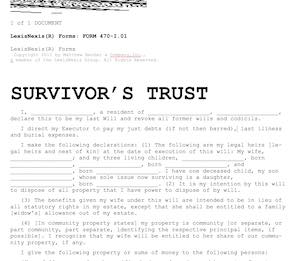Survivor’s Trust

A survivor’s trust is a surviving spouse’s share of a main trust that is created by a married couple. In this main trust, when the first spouse dies, two to three sub-trusts are created (depending on value of the trust assets), one of which is the survivor’s trust.
The survivor’s trust is a revocable trust of the surviving spouse, which the surviving spouse has full control over and which will form part of his estate upon death. This type of trust arrangement has been used by blended families and high net worth couples who wish to minimize, if not eliminate, estate taxes.
It is easier to understand a survivor’s trust through an example. Before providing an example, one must understand the basic concept of a trust, which is a legal arrangement where a grantor or grantors (the creator/s of the trust) transfer their assets to a trustee, who legally owns such assets and manages such assets for the benefit of the grantor’s named beneficiaries.
In a survivor’s trust, a main trust is first established by a married couple, and the survivor’s trust is only created upon the first death of a grantor-spouse. The survivor’s trust is the share of the surviving spouse in the trust assets that is revocable and completely under the control of the surviving spouse.
For example, you are married to B, with both of you each having two children from your previous marriages. You have C and D as your children from your first marriage, while B has her own children, E and F, from her first marriage. You and B have a common child, G.
You and B, as doctors, have amassed a sizeable amount of property together. Because you have children from previous marriages, you both decide it’s better to put your properties in a trust. You and B establish ABC Trust where you both transfer your individual bank accounts, your 3-bedroom co-op in Chelsea, and a 4-bedroom house in Montauk to ABC Trust. You also name ABC Trust as a beneficiary in your IRA and your stock brokerage account. You died first with no estate assets. All your assets are held by ABC Trust. Upon your death, ABC Trust’s assets are worth $12,500,000 broken down as follows:
- Your individual bank account worth $1 million
- B’s individual bank account worth $1,500,000
- The three-bedroom coop in Chelsea worth $2 million
- The Montauk house at $5 million
- Your IRA account worth $1,000,000
- Your stock brokerage account worth $2 million
Generally, under the terms of this kind of trust, upon one’s spouse’s death, two to three sub-trusts are created (depending on the value of the trust):
- the survivor’s trust
- the marital deduction trust (QTIP trust)
- the bypass trust (the credit shelter trust)
Upon the death of one spouse, the trust assets are divided into two: the survivor spouse’s share and the deceased spouse’s share. The surviving spouse’s share will go to the survivor’s trust, a revocable trust where the surviving spouse is free to do whatever he pleases with the trust assets. The deceased spouse’s share will be distributed to both the marital deduction trust (QTIP) and the bypass trust (the credit shelter trust), in accordance with deceased spouse’s wishes.
Usually, both the marital deduction (QTIP) trust and bypass (credit shelter) trust provide that the income of the trust assets go to the surviving spouse but upon the surviving spouse’s death, the trust assets are distributed to the ultimate beneficiaries, which are the children.
The difference between the QTIP trust and the credit shelter trust is that the QTIP trust forms part of the surviving spouse’s estate, while the credit shelter trust forms part of the deceased spouse’s estate. For this reason, most estate planning lawyers use first the credit shelter trust up to the amount of state exclusion exemption from estate tax, and any excess goes to the QTIP trust.
In this case, since the value of ABC Trust is $12,500,000, the surviving spouse’s share is half of ABC Trust’s assets equivalent to $6,250,000, which goes to the survivor’s trust. Thus, B will receive $6,250,000 from ABC Trust, and this amount will be placed in the survivor’s trust. B can direct the management of the assets in the survivor’s trust in any way or manner since it is a revocable trust. B can change the beneficiaries, can change the terms and conditions, or sell all the assets in the survivor’s trust. On the other hand, the other half goes to your share as the deceased spouse.
In New York, the basic exclusion amount in 2021 is $5.93 million. For a net estate in excess of $5.93 million, the difference between the net estate and the basic exclusion amount is subject to estate tax. However, if the estate is more than 105% of the basic exclusion amount (which is $6,226,500), the entire estate is taxable. This is called the estate tax cliff where the entire value of the estate is taxable when it reaches a certain amount.
Here, even if the assets are in the trust, it does not escape estate taxes. It only escapes probate. The deceased share’s spouse is P6.25 million. Not only is it subject to estate tax in New York, it is subject to the estate tax cliff where the entire amount is taxable. Without any trust, your estate will pay $522,800 plus 12.8% of the amount in excess of $6,100,000 (or 12.8% of 150,000, which is $19,200). Thus, the total estate tax for a net taxable estate of $6,100,000 is $542,000. However, since there is a credit shelter trust and QTIP trust in this case, you will be able to save on, if not eliminate, estate taxes.
Estate planning lawyers will generally put trust assets equivalent to the entire exclusion amount to the credit shelter trust and transfer the rest to the QTIP trust. Why? Because the assets in QTIP trust form part of the surviving spouse’s estate when the surviving spouse dies, and is thus, subject to estate tax.
Here, $5,930,000 is placed in the credit shelter trust, while the remaining $320,000 is placed in the QTIP trust. This allows the estate to save on taxes. In both the credit shelter trust and the QTIP trust, the income of these trusts’ assets can be used by the surviving spouse. The surviving spouse can even use the principal of the QTIP trust to maintain her standard of living.
In some cases, the principal of the credit shelter trust can also be used by the surviving spouse, subject to certain conditions. However, in both the credit shelter trust and QTIP trust, the surviving spouse cannot change the designated beneficiaries.
If you decide that the ultimate beneficiaries of the QTIP trust and credit shelter trust are your children, B, C, and G, your surviving spouse cannot change this. Upon your death, the QTIP trust and credit shelter trust become irrevocable. The surviving spouse can only change the terms and conditions in the survivor’s trust which comprises her share of the main trust’s assets.
Because estate taxes are only required for high value estates, most people do not use credit shelter trusts or QTIP trusts. However, it may still be used for blended families, when a person only wants the surviving spouse to receive the income, but not the trust asset, saving such asset for the ultimate beneficiaries, which are usually children from a previous marriage.
A survivor’s trust is normally created in conjunction with a QTIP or credit shelter trust.
If you are interested in a survivor’s trust, a QTIP trust, or a credit shelter trust, or you would like to save on estate taxes, we at the Law Offices of Albert Goodwin are here for you. We have offices in New York City, Brooklyn, NY and Queens, NY. You can call us at 212-233-1233 or send us an email at [email protected].
